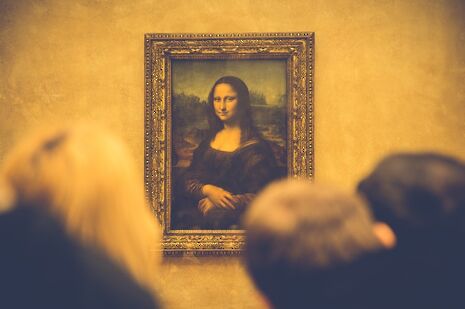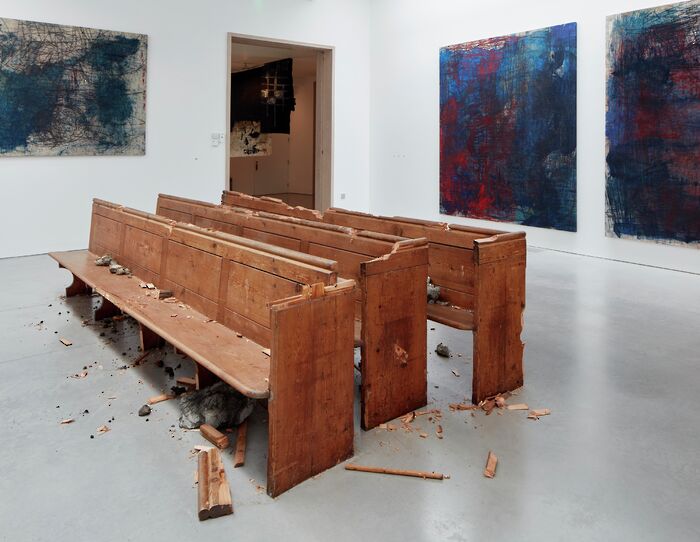Hanging a painting
Mahi Shah considers the power of the gallery space in our interactions with art

Oscar Wilde once wrote that ‘the artist should never try to be popular. Rather the public should be more artistic’. If the power of art lies in the subjectivity of the viewer, it falls upon us, as individuals, to engage with, relate to and interpret works of art. The viewer’s interaction with a work of art undeniably determines how the art is received; the gallery space refines and conditions this interaction, and yet it is often overlooked.
By hanging paintings, framing photographs and orchestrating sculptures in a particular way, galleries are able to control a layer of the representation of artwork. In 2014, the Gagosian had to demolish and reconstruct most of its gallery walls to fit in Richard Serra’s quartet of steel sculptures; adapting a space to present art is necessary to facilitate its most effective portrayal and subsequent interpretation.
Gallery spaces complicate our judgement of modern art
The art world embodies an extensive range of contexts for display, and Cambridge easily showcases this diversity. The contemporary design of the Heong Gallery conveys something akin to the White Cubes and the Gagosians of London, and the grandeur of the Fitzwilliam mirrors the tone of the National Galleries. Such juxtaposing contexts share the same intention of best communicating art to its audience, catering perhaps for both different artists and audiences. Yet we often only encounter critique or commentary of the pieces themselves, when perhaps it is the subtleties stemming from the coordination of gallery space which should be at the forefront of our interpretation.
To focus on the Heong Gallery for a moment, its most fundamental stylistic feature is the neutrality and openness of its space. The stripped-back emptiness offers isolation from the external world, and room to interpret and perceive freely. The ‘White Cube’ concept brings in an aesthetic introduced at the beginning of the 20th century to contextualise the growing abstraction of modern art. Yet by elevating works to a certain level of a perceived modernist aesthetic, such gallery spaces arguably complicate our judgement of modern art.
Rather than looking across the spectrum of the art world, the viewer tends to look to these spaces to inform their idea of what constitutes modern art, perhaps to such an extent that the 20th-century image of art is not a specific style, but rather centred around the clean, white exhibition space. The gallery is granted a power, a power to transform pieces into aesthetic works to be received by the viewer in the conditions the gallery prescribes with its very function.
Street art grants the artist absolute power over the context of their work
The timelessness of these contemporary galleries is the polar opposite of the personality epitomised by more traditional establishments. Can we ever truly consider works of art displayed in such galleries independently from the decor, given all its cultural and historical connotations? If we were to transfer the artwork into a different gallery space, one where the interior design did not boast its own temporality and societal conditions, would the effect of the work be the same? Perception is heavily dependent on the individual’s surroundings, susceptible to external influences and atmospheric factors. By either minimising or amplifying different features, galleries either encourage personal interpretation or attempt to inform the viewer through contextualisation. Yet the question remains whether an isolated White Cube-style space simplifies the observation process for the viewer, or whether it is altogether more challenging.
If we move beyond these two categories, exploring other sites of representation, our consciousness of the role of gallery space will necessarily become more complicated. Street art grants the artist absolute power over the context of their work. In a location defined by its relationship with the ‘real world’ and and vulnerable to public opinion, street art’s effect is dependent on its relationship with the site. Transported to a gallery space, the same art would be limited in its power, its spontaneity, independence and freedom all stifled. Street art creates a new context, and acknowledges how specific platforms shape pieces’ reception.
The spaces where art is to be found all have an effect on the way we respond to it, constraining or empowering, leaning in to traditional contexts or throwing them away altogether. It is up to the individual viewer to choose how we value the space surrounding art, and it is up to the individual to embrace the complexity of creativity in an entirely different way.
 News / Clare Hall spent over £500k opposing busway 24 December 2025
News / Clare Hall spent over £500k opposing busway 24 December 2025 Comment / The ‘class’ of Cambridge24 December 2025
Comment / The ‘class’ of Cambridge24 December 2025 News / Caius mourns its tree-mendous loss23 December 2025
News / Caius mourns its tree-mendous loss23 December 2025 Comment / League tables do more harm than good26 December 2025
Comment / League tables do more harm than good26 December 2025 News / Girton JCR publishes open letter expressing solidarity with Palestine25 December 2025
News / Girton JCR publishes open letter expressing solidarity with Palestine25 December 2025









